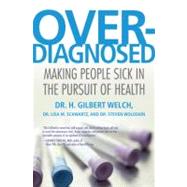
| Introduction: Our Enthusiasm for Diagnosis | p. ix |
| Genesis: People Become Patients with High Blood Pressure | p. 1 |
| We Change the Rules: How Numbers Get Changed to Give You Diabetes, High Cholesterol, and Osteoporosis | p. 15 |
| We Are Able to See More: How Scans Give You Gallstones, Damaged Knee Cartilage, Bulging Discs, Abdominal Aortic Aneurysms, and Blood Clots | p. 32 |
| We Look Harder for Prostate Cancer: How Screening Made It Clear That Overdiagnosis Exists in Cancer | p. 45 |
| We Look Harder for Other Cancers | p. 61 |
| We Look Harder for Breast Cancer | p. 73 |
| We Stumble onto Incidentalomas That Might Be Cancer | p. 90 |
| We Look Harder for Everything Else: How Screening Gives You (and Your Baby) Another Set of Problems | p. 102 |
| We Confuse DNA with Disease: How Genetic Testing Will Give You Almost Anything | p. 116 |
| Get the Facts | p. 136 |
| Get the System | p. 151 |
| Get the Big Picture | p. 167 |
| Conclusion: Pursuing Health with Less Diagnosis | p. 180 |
| Acknowledgments | p. 192 |
| Notes | p. 194 |
| Index | p. 218 |
| Table of Contents provided by Ingram. All Rights Reserved. |
The New copy of this book will include any supplemental materials advertised. Please check the title of the book to determine if it should include any access cards, study guides, lab manuals, CDs, etc.
The Used, Rental and eBook copies of this book are not guaranteed to include any supplemental materials. Typically, only the book itself is included. This is true even if the title states it includes any access cards, study guides, lab manuals, CDs, etc.